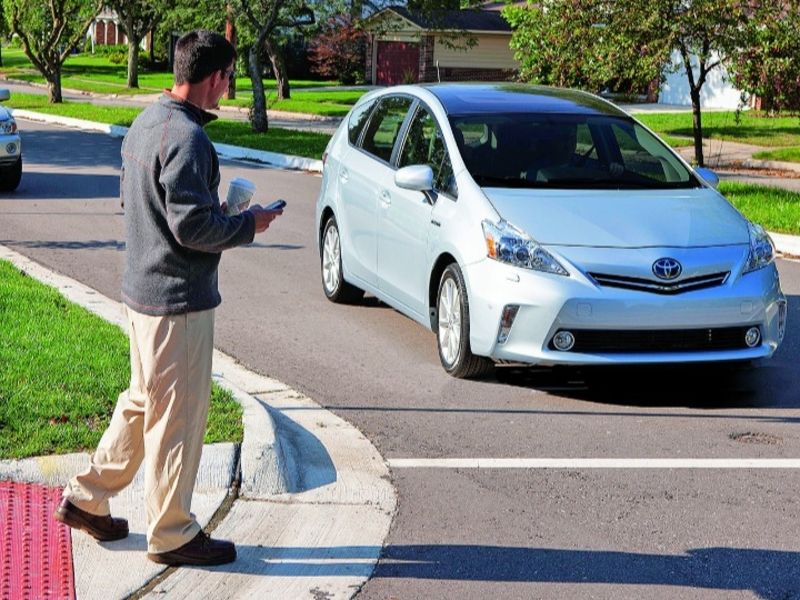
Cars need more than a clear view of the road ahead for new safety technology to fulfill its lifesaving potential. They need a better idea of what’s happening along the periphery of their paths.
As transportation officials struggle to address a dramatic and chronic increase in pedestrian deaths on U.S. roadways, automakers and suppliers are introducing technology that improves the effectiveness of systems such as automated emergency braking.
They are enhancing the performance and placement of cameras and radar sensors that are better designed to spot pedestrians and bicyclists who emerge from the sides of a vehicle path. Those road users can be tricky to spot for motorists and driver-assist systems alike.
“It’s very sad because there’s technology that exists that can address these things,” said Kay Stepper, vice president of driver assistance and automated driving at Bosch.
Even as new technology makes vehicles safer for occupants, travel has grown more deadly for pedestrians and bicyclists. In 2018, the most recent year for which there is federal data, 6,283 pedestrians were killed in traffic crashes — 17 percent of overall traffic deaths. That’s up 3.4 percent from the previous year, and it’s the highest number in more than two decades.
It’s not a one-year anomaly. During the 10-year period from 2009 through 2018, pedestrian fatalities increased by 53 percent, while all other traffic deaths combined increased by 2 percent, according to the Governors Highway Safety Association, which estimates pedestrian fatalities rose another 5 percent in 2019.
Jonathan Adkins, the organization’s executive director, says the underlying causes of the spiral are numerous, from poor infrastructure to speeding drivers to vehicle design. In-vehicle technology can be part of the solution.
“Technology has to be part of it, but we can’t assume that technology is going to fix all these problems that are behavior-related,” he said.
An October study from motoring organization AAA laid bare the limitations of current technology. In testing four automated emergency braking systems, researchers found inconsistent performance and that systems were “completely ineffective” at night, when most pedestrian fatalities occur.
Further, immediately following right turns, all of the test vehicles collided with simulated adult pedestrians, according to the study. That’s one scenario that can be tricky for driver-assist systems to handle in the real world — and it’s one that suppliers have addressed with new products.
In July, supplier ZF introduced a monocular camera with a 100-degree field of view that allows for more reliable detection of pedestrians and cyclists in turning scenarios. It almost doubles the 52-degree field of view from the previous generation.
When multiple features such as lane keeping, automated emergency braking and adaptive cruise control are operated from a single camera, automakers often have to make compromises between high-speed highway and low-speed city applications. That may no longer be the case.
“With the 100-degree field of view, we can see our lanes just as far on the highway,” says Andy Whydell, vice president of systems product planning for ZF. “We can now evaluate all these extra pixels on the side, and that’s specifically for urban applications to be able to look for crossing pedestrians and cyclists in a much wider range of different city scenarios.”
The improvements are driven by innovation — image resolution has increased from 1.2 megapixels on standard cameras to 1.7 megapixels on ZF’s latest, Whydell said.
They’re also driven by new benchmarks set by Europe’s New Car Assessment Program, designed to better protect vulnerable road users. This year, the program introduced two new scenarios to its testing regimen, including one in which a car turns into a simulated pedestrian.
ZF has added a pair of forward-facing, short-range radars to the corners of automated emergency braking systems that complement camera technology and further stretch the field of view to 180 degrees. They will help detect cyclists and scooters in Asia, where vulnerable road users comprise a greater percentage of traffic fatalities.
“That 6,000 number is terrible here,” Whydell said. “But it’s also a reminder that it’s a lot worse elsewhere.”
At Bosch, Stepper has worked to expand the field of view of single radar units. The company’s fifth-generation system has an improved field of view and angular resolution to detect pedestrians earlier. Radar typically is best used to detect larger, metallic objects, but Stepper says it can be optimized to detect people.
“We are very high in water content, and there is a strong reflection from that,” he said. “But in order to catch that, when you have a laterally crossing pedestrian, you need a wide detection range.”
Detecting is only half the prevention problem. Responding to detections is equally challenging. Along those lines, Bosch has introduced a braking system that, with an electromechanical boost, can initiate full braking in 190 milliseconds from a detection, Stepper says.
Still, the best way to prevent deaths may be to focus on deterring problems before vehicle technology ever needs to be relied upon.
While there is not yet firm data on pedestrian fatalities during the COVID-19 era, Adkins hopes the pandemic may provide an inadvertent silver lining by emphasizing the need for better infrastructure as more people take walks and eat outdoors.
“There’s an opportunity with COVID to prioritize pedestrian space,” he said “Our infrastructure has not kept up with that. So we’re really hopeful these trends of people getting out more will push for more infrastructure — more protected walkways — and being able to get somewhere on a bicycle or on foot.”